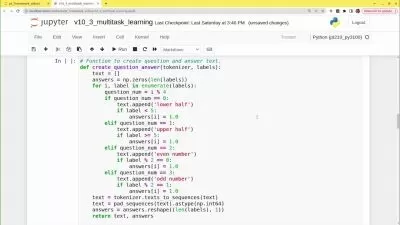Deep Reinforcement Learning made-easy
11:20:40
Description
Reinforcement Learning for beginners to advanced learners
What You'll Learn?
- To understand deep learning and reinforcement learning paradigms
- To understand Architectures and optimization methods for deep neural network training
- To implement deep learning methods within Tensor Flow and apply them to data
- To understand the theoretical foundations and algorithms of reinforcement learning
- To apply reinforcement learning algorithms to environments with complex dynamics
Who is this for?
What You Need to Know?
More details
DescriptionThis course is the integration of deep learning and reinforcement learning. The course will introduce student with deep neural networks (DNN) starting from simple neural networks (NN) to recurrent neural network and long-term short-term memory networks. NN and DNN are the part of reinforcement learning (RL) agent so the students will be explained how to design custom RL environments and use them with RL agents. After the completion of the course the students will be able:
To understand deep learning and reinforcement learning paradigms
To understand Architectures and optimization methods for deep neural network training
To implement deep learning methods within Tensor Flow and apply them to data.
To understand the theoretical foundations and algorithms of reinforcement learning.
To apply reinforcement learning algorithms to environments with complex dynamics.
Course Contents:
Introduction to Deep Reinforcement Learning
Artificial Neural Network (ANN)
ANN to Deep Neural Network (DNN)
Deep Learning Hyperparameters: Regularization
Deep Learning Hyperparameters: Activation Functions and Optimizations
Convolutional Neural Network (CNN)
CNN Architecture
Recurrent Neural Network (RNN)
RNN for Long Sequences
LSTM Network
Overview of Markov Decision Processes
Bellman Equations and Value Functions
Deep Reinforcement Learning with Q-Learning
Model-Free Prediction
Deep Reinforcement Learning with Policy Gradients
Exploration and Exploitation in Reinforcement Learning
Who this course is for:
- Data Scientists
- Machine Learning Engineers
- Robotics Programmer
This course is the integration of deep learning and reinforcement learning. The course will introduce student with deep neural networks (DNN) starting from simple neural networks (NN) to recurrent neural network and long-term short-term memory networks. NN and DNN are the part of reinforcement learning (RL) agent so the students will be explained how to design custom RL environments and use them with RL agents. After the completion of the course the students will be able:
To understand deep learning and reinforcement learning paradigms
To understand Architectures and optimization methods for deep neural network training
To implement deep learning methods within Tensor Flow and apply them to data.
To understand the theoretical foundations and algorithms of reinforcement learning.
To apply reinforcement learning algorithms to environments with complex dynamics.
Course Contents:
Introduction to Deep Reinforcement Learning
Artificial Neural Network (ANN)
ANN to Deep Neural Network (DNN)
Deep Learning Hyperparameters: Regularization
Deep Learning Hyperparameters: Activation Functions and Optimizations
Convolutional Neural Network (CNN)
CNN Architecture
Recurrent Neural Network (RNN)
RNN for Long Sequences
LSTM Network
Overview of Markov Decision Processes
Bellman Equations and Value Functions
Deep Reinforcement Learning with Q-Learning
Model-Free Prediction
Deep Reinforcement Learning with Policy Gradients
Exploration and Exploitation in Reinforcement Learning
Who this course is for:
- Data Scientists
- Machine Learning Engineers
- Robotics Programmer
User Reviews
Rating

Udemy
View courses Udemy- language english
- Training sessions 82
- duration 11:20:40
- Release Date 2025/03/09








